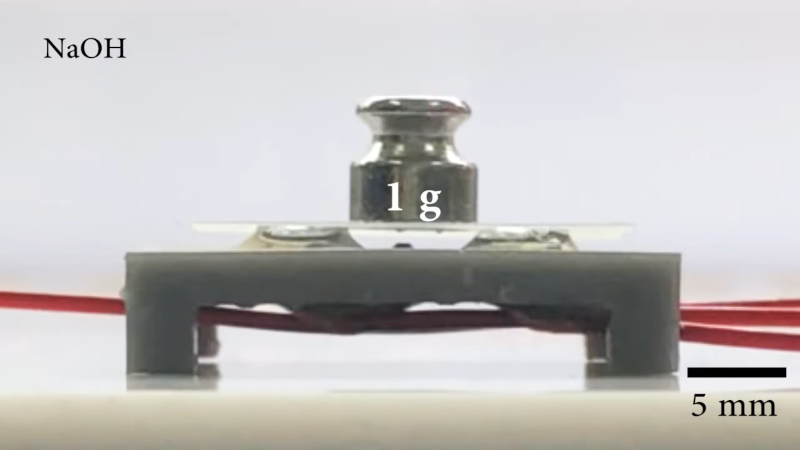In the movie Terminator 2, the T-1000 robot was made of some kind of liquid metal that could change shape among other interesting things. According to a chemical engineer at North Carolina State University, there may be something to the idea. [Michael Dickey] has been experimenting with gallium, a liquid metal, that scientists think may unlock a new generation of flexible devices.
The most common liquid metal is mercury, of course, and it has its uses. However, its toxicity has led to a reduction in its use. Gallium has low toxicity and also doesn’t easily evaporate. What can you do with it? Check out the video below to see a very simple demonstration of the liquid metal lifting a small — very small — weight with an electrical impulse.
Like most metals, gallium transfers heat and electricity readily but can change shape without the fatigue associated with normal metals. Imagine, for example, headphones that have liquid metal wires that can stretch without breaking. [Dickey] has made them. Self-healing is possible, too, since liquid metal wires would flow together — no soldering needed.
Other properties of the material make it useful for sensing deformation. For example, a mesh of liquid metal wires in a glove could help a VR system understand your hand’s gestures. One downside is that when exposed to air, the material forms a thin oxide layer. However, this also offers some advantages in fabrication that they mention in the post.
Of course, this is far from practical today, but it might just be a technology to watch. We have seen a few flexible boards taking advantage of liquid metal compounds that contain gallium so there is some practical application today. Combined in stretchable substrates like silicone, they can do some pretty amazing things.















T1000
Dammit! maybe one day our new robot overlords will give us an “edit button” for us, naturally defective humans
we will give you an edit button, but it will cause you to self immolate.
this message comes to you from the future.
I work in pulsed power, I tried using gallium as a self healing surface for high energy mechanical switches, but it’s a very tricky thing once you’re dealing with high energy levels. This group looks like they’re onto some cool stuff!
Beware that gallium readily interacts with aluminum. Lookup gallium and soda/pop can on YouTube to see the results. Can gallium be made to not interact with components in my car? What about the many homes with aluminum electrical wiring built between 1965 and 1972? Everyone thought asbestos was the greatest building material ever discovered in the 1930’s until problems with it were thoroughly documented and it became a very costly mistake to remove.
Asbestos _was_ the greatest building material ever discovered. It just turned out to be too toxic to humans to use it. We still have no alternative to all the properties of asbestos, however the replacements are for the most part good enough. It’s a shame, I would have loved to see the napkin-in-the-fire trick!
Liquid metal wires that can self-heal… assuming you can find a plumber, and then get a syringe of liquid metal to re-fill it?
How does the gallium lifting a weight work? I can’t seem to find details about that.
@Programmer Dude (@koppanyh) said: “How does the gallium lifting a weight work? I can’t seem to find details about that.”
An electric current changes the surface tension of gallium, allowing it to lift and lower a weight.[1][2][3]
Be careful, gallium (like mercury but far less poisonous) combines with (and weakens) other metals through the process of amalgamation.[4][5]
1. Giant and switchable surface activity of liquid metal via surface oxidation
https://www.pnas.org/doi/10.1073/pnas.1412227111
2. Gallium Liquid Metal: The Devil’s Elixir
https://www.annualreviews.org/doi/10.1146/annurev-matsci-080819-125403
3. Gallium: The Liquid Metal That Could Transform Soft Electronics
https://www.qualitydigest.com/inside/innovation-article/gallium-liquid-metal-could-transform-soft-electronics-052522.html
4. Amalgam (chemistry)
https://en.wikipedia.org/wiki/Amalgam_(chemistry)
5. Amazing – What Gallium does to an Aluminium Can
https://www.youtube.com/watch?v=IgXNwLoS-Hw
@Programmer Dude
Just follow the link given in the article. It’s all in there.
The second-to-last link is wrong; it just goes to the same video.
Oops… fixed.
Just don’t mix the gallium with your aluminum parts; if it comes in contact with unprotected aluminum it can form an amalgam which weakens the aluminum.
As fun and beautiful as these gallium experiments may be, I am left wondering how they fit into our world of structural aluminium parts.
I had assumed the Terminator was made entirely of nano-bots or “smatter” to use an Ian Banks term. “Liquid metal” is very disappointing.
“headphones that have liquid metal wires that can stretch without breaking. [Dickey] has made them”
Can you give the link?